Trip Report: Alternative Spring Break in Belize
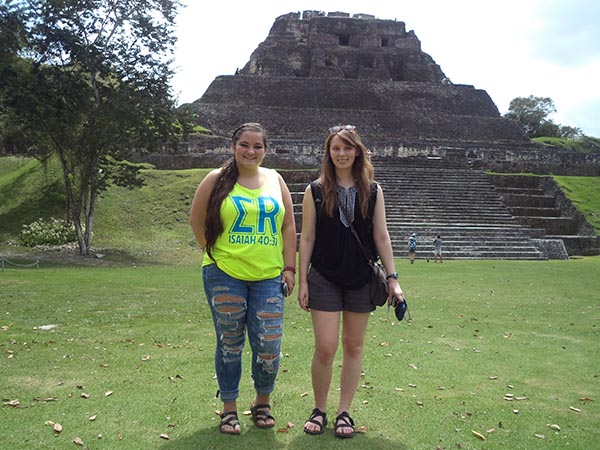
- Read Kelly Arnholt’s report on the Belize trip »
- Read Camille Bergin’s report on the Belize trip »
- Read Quanita Choudhury’s report on the Belize trip »
- Read Lydia Cole’s report on the Belize trip »
- Read Bonnie Craighead’s report on the Belize trip »
- Read Nicolo Franceschetti’s report on the Belize trip »
- Read Daniel Garza’s report on the Belize trip »
- Read Katherine Krouse’s report on the Belize trip »
- Read Ryan Marine’s report on the Belize trip »
- Read Jessica Martinez’s report on the Belize trip »
- Read Robert Nickle’s report on the Belize trip »
The TCE Alternative Spring Break of 2016 took place in San Ignacio, Belize, from March 12 – 19. This marks the first joint project between TCE, who sponsored the trip, and the Chancellor’s Honors Program. An application process was used to select the fifteen attendees: engineering majors Catherine Weiss, Nicolo Franceschetti, Katherine Krouse, Daniel Garza, Robert Nickel, Ryan Marine, Rhett Sexton, Samantha Thorpe, and Camille Bergin were joined by honors non-engineers Bonnie Craighead, Kelly Arnholt, Lydia Cole, Jessica Martinez, Victoria Webb, and Quanita Choudhury. TCE International Coordinator Judith Mallory led the trip.
This marks the second visit by UT engineers to Belize, a former British Crown Colony which gained independence in 1981. The country’s 9,000 square miles are ethnically, geographically, and culturally diverse. Belize is divided into four “districts,” the Cayo District being the group’s destination. The most significant Mayan archaeological sites are in this area. The Maya and Garifuna cultures are predominant, but members of the country’s other ethnic groups, Mestizo, Spanish, and Creole are present there as well. The Cayo District is also home to several thriving Mennonite communities.
The group was collected at the airport for the drive to San Ignacio by Mr. Jaime Marin, who served as host, in-country coordinator, and project foreman. San Ignacio forms the chief population center of the Cayo District, located on the west bank of the Macal River.
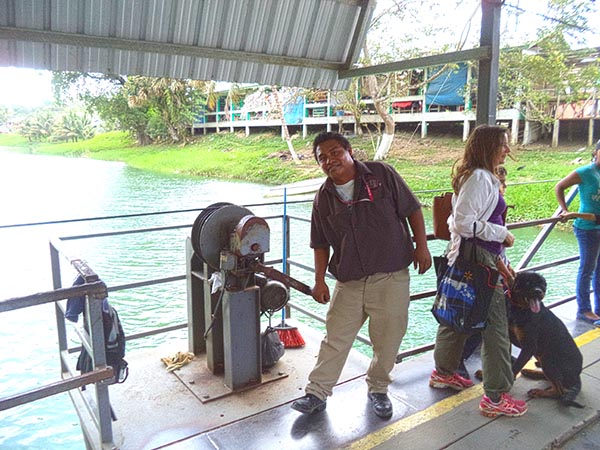
The first full day consisted of a short orientation and a quick tour of the town of San Ignacio. The group traveled in a southwesterly direction to visit the Mayan archaeological site of Xunantunich. The van drove onto a small, hand-cranked ferry for passage across the Mopan River along the way to the ruins. The temples at Xunantunich date to the 7th century. On the way back into town was another stop at Mayan ruins, Cahal Pech, the oldest known Mayan site in the Belize River valley, having first been settled between 1500 and 1000 BC. Cahal Pech is Mopan and Yucatec Mayan for “Place of Ticks,” as the site was at one time surrounded by pastures grazed by tick-infested cattle.
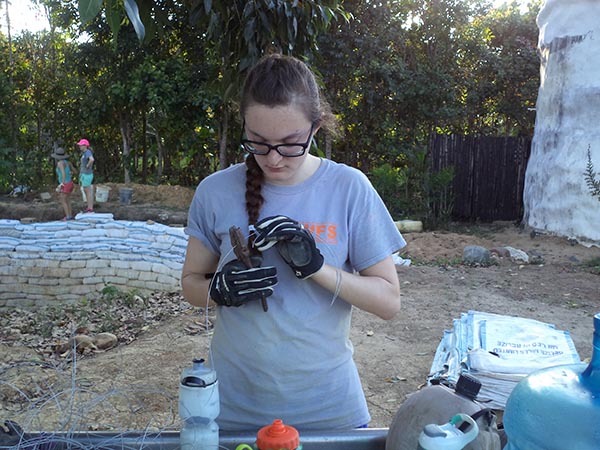
After lunch, the group traveled to the sustainable farm that was to be the project site for the week, for an orientation to the process of constructing the earth bags. In May of 2015, a group of UT engineering students started construction of the root cellar/earth bag project, and this group would continue lining the walls of the cellar as their project for the week. Essentially, earth bag construction involves filling bags with whatever material is available, in this case, a sand/rock/soil mixture that was removed from the ground to form the surround of the cellar. A prescribed amount of lime is added to the mixture with a bit of water, then shoveled into a recycled polypropylene feed sack, fastened at the top with a wire. This forms a “block” of the wall, which is laid on the bags below it before being tamped with a tool to flatten and remove air pockets. Earth bag technology is appropriate for this part of the world because of earthquakes; they can accommodate shifts without causing the building to collapse. In addition, their cost is far less expensive than traditional post-and-beam construction. This project remains the most labor-intensive of any so far attempted by Global Initiatives. It is notable that the original UT group laid the first earth bag in the cellar, and the current group laid the last, as the cellar walls were deemed complete upon the end of the last day of work. The root cellar was began and completed by students from The University of Tennessee.
The farm will eventually serve as home for orphan girls aging out of the foster system in Belize. Plans include residents learning farming skills in order to be self-sustaining, as well as an apprenticeship program for various job skills. There is a small orchard on site, a vegetable and herb garden, coconut palm trees, and a variety of animals for both food and therapy, including peacocks, pheasants, geese, ducks, turkeys, chickens, and sheep.
A highlight of the work at the farm was a visit from Friends of the College, Madeline and Paul Bunch – Mr. Bunch is a TCE Mechanical graduate. They were visiting Belize at the same time and brought the group a picnic at the worksite, complete with homemade Belizean tamales, tropical fruit, roast chicken, and cupcakes bearing the Power T logo. Everyone was given an orange and white UT bandana, which came in handy while working in the heat.
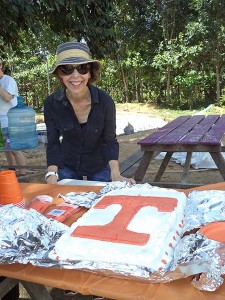
After a physically demanding work week, the group got to experience several cultural activities, the biggest of which was a trip over the border into Guatemala to visit the most significant Mayan archaeological site in Central America, Tikal. The students observed a family of pizotes crossing the road, several monkeys, tropical birds including toucans, a large scorpion, and a tarantula. A multi-lingual Guatemalan tour guide, Edgar, escorted the group around the grounds, stopping to explain details about the site, trees and foliage, and the process involved in reclaiming the temples.
The final full day consisted of three activities. The group started by visiting the Mennonite settlement of Springfield, founded in 1996 as a daughter colony of the Upper Barton Creek settlement of very conservative Mennonites, who settled in Canada, the US, and Mexico before they came to Belize. These Mennonites belong to the Noah Hoover branch of Old Order Mennonites, with a sister settlement in Delano (Polk County), Tennessee. The group first visited with Mr. David, father of ten, who operates a fruit tree nursery. Mr. David and all of the other residents seen by the group sported traditional Mennonite dress, with blue shirts, dark trousers, suspenders, and straw hats for the men and boys, and long gray cotton dresses and sun bonnets for the women and girls. He gave the group some insight into their non-electric way of life and had his son demonstrate a horse-operated contraption that ran a cement mixer. Down the road, the students observed a horse-powered saw mill. The last stop was to Mr. David’s uncle’s home, an attractive, yet unpainted structure where everyone was invited to sit on hand-made chairs in the shade and visit with Mr. John, who further emphasized the importance of self-sufficiency, hard work, and cooperation. The Mennonites leave their homes unadorned and free of paint to avoid the appearance of vanity, which does not have a place in their belief system. He had a sizeable windmill which powered an impressive shop containing all manner of mechanical equipment. The village population of 270 residents is composed of forty families, who speak Plautdietsch, or Low German, in the home. They have large families, averaging 6.8 persons per household.
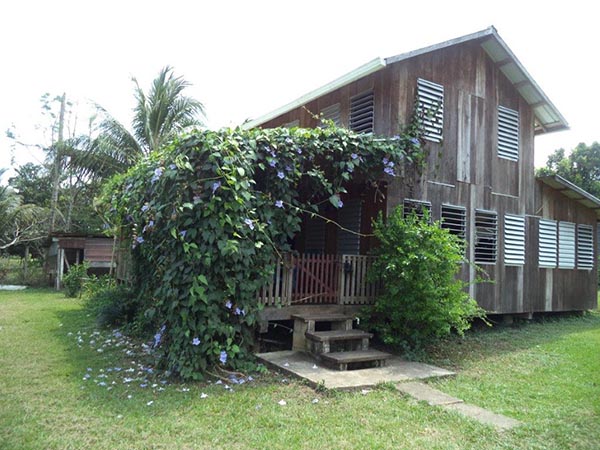
The students then visited St. Herman’s Blue Hole National Park for a quick swim and visit to the St. Herman’s Cave. The day ended with a horseback ride at a large ranch, followed by dinner. On the way to the airport on the day of departure, several members of the group visited the Community Baboon Sanctuary, a grassroots conservation operation which has engineered an impressive increase in the primate’s local population. Interestingly, Belizeans refer to what is actually the Yucatan Black Howler Monkey, a New World Monkey, as a baboon. Spread over a twenty square mile area, the sanctuary borders several Creole villages in the Belize River Valley. More than 200 landowners have signed agreements to preserve the monkeys’ habitat by protecting forested areas. The “howl” of this monkey routinely reaches eighty-eight decibels, making it the loudest of all land animals, including the lion. The group visiting the sanctuary got to hear this first-hand, when Geraldine, the Belizean guide, became involved in a howling match with one of the males in residence.
All of the group members arrived home with a day to rest before resuming classes for the Spring semester.